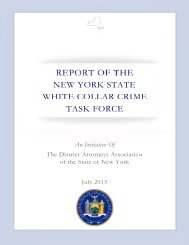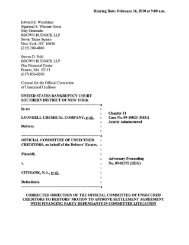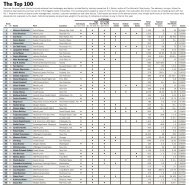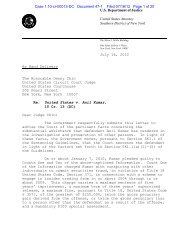Salz Review - Wall Street Journal
Salz Review - Wall Street Journal
Salz Review - Wall Street Journal
You also want an ePaper? Increase the reach of your titles
YUMPU automatically turns print PDFs into web optimized ePapers that Google loves.
87<br />
<strong>Salz</strong> <strong>Review</strong><br />
An Independent <strong>Review</strong> of Barclays’ Business Practices<br />
8.36 Compared with other parts of Barclays, the investment bank lacked history. So its<br />
leaders had an opportunity to define their own cultural context. The investment<br />
bankers tended to regard the retail bank as slow, indecisive and un-commercial. In<br />
contrast, the investment banking characteristics were hard-working, fast, competitive<br />
and well rewarded for success. So despite being part of the Group and benefiting<br />
from a lower cost of funds supported by a single credit rating, and retail inflows, the<br />
investment bank tended not to recognise the relevance of Group and was never<br />
likely to adopt its culture.<br />
8.37 Nor was it likely to adopt the culture of Barclays’ Corporate Bank (or its Business<br />
Bank) which, while quite distinctive and emphasising integrity, was described by a<br />
number of interviewees as being relatively conservative, hierarchical and slowmoving<br />
– perhaps reflecting an emphasis on tenure and loyalty over performance.<br />
8.38 The culture in Barclays Capital was influenced from its inception by its need to hire<br />
people to build the business. And Barclays did build, almost from scratch, a worldclass<br />
investment bank – which no other UK bank had achieved in the same period of<br />
time. The mantra was to hire the best people – and as a challenger, Barclays Capital<br />
often had to pay a premium. This reinforced a tendency to apply disproportionate<br />
value to personal commercial performance as well as to assume that simply<br />
increasing compensation would resolve issues at senior levels. While compensation<br />
overall was broadly in line with peers, compensation for the ‘group of 70’ most<br />
highly-paid executives 154 was consistently and significantly above the peer group<br />
median (see Section 11). The stable, close-knit leadership team brought continuity,<br />
experience and a common understanding. We were also told that this made it hard<br />
for others to inject challenge.<br />
8.39 The Lehman acquisition instantly increased the size and complexity of the<br />
investment bank leadership challenge. Lehman had a distinct culture and the<br />
combined organisation triggered issues of size and complexity. Running this larger<br />
organisation undoubtedly demanded more emphasis on formal systems and<br />
processes. But many of our interviewees told us that while some members of<br />
Barclays Capital’s top team inspired and valued loyalty, the team disliked bad news.<br />
This all combined to create an environment in which leaders were rarely effectively<br />
tested or challenged, contributing to a sense of ambiguity about what was considered<br />
right and wrong.<br />
8.40 We also heard evidence of human resources leaders who lacked authority to impose<br />
policies and exert sufficient authority to influence how the business was led (see<br />
Section 10). Reluctance by staff to escalate issues, coupled with an expectation that<br />
employees needed to show that they could resolve problems themselves, rather than<br />
look to others to do so, created a culture that lacked openness. Given these<br />
dynamics, we did not find it surprising that some in Barclays Capital failed initially to<br />
154 For the purposes of the report we defined this group as including Executive Committee members in<br />
Group, RBB, WIM and CIB; IB employees earning more than £5m; and any employees in RBB, WIM<br />
and CB who are one of the top ten highest earners in their business unit but are not on the Executive<br />
Committee. This group received the most scrutiny from the Board Remuneration Committee, and the<br />
number of executives varied slightly year on year.
















